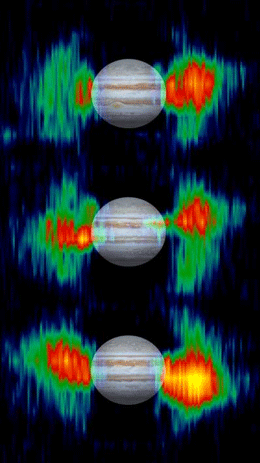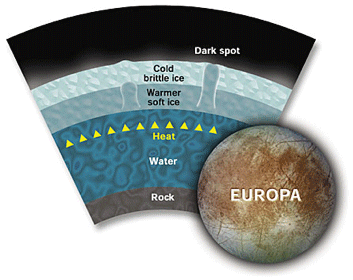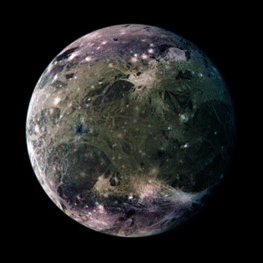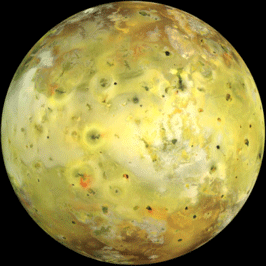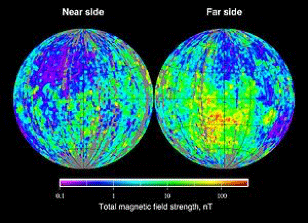What’s Up? Magnetic Moons?
By Lou Mayo
Magnetic fields are all around us. They are generated quite simply by the movement of charge….electricity! Every piece of electronics you work with generates a magnetic field. The Earth and Sun also generate their own magnetic fields as do the outer planets (Jupiter, Saturn, Uranus, and Neptune). Recent spacecraft observations of Jupiter’s largest moons suggest that most of them also have magnetic fields, some that they generate on their own and some that need a little help.
Magnetic fields can tell us a lot about the interiors of solar system objects. Within some solar system bodies, global magnetic fields or “dipoles” are generated deep inside the object, by the rotational flow of charged particles. This allows scientists to probe the interiors of these bodies by observing and measuring their magnetic fields. The rotation of this electrically charged material is called a dynamo. In the sun, it takes the form of hot plasma gas, in the Earth, a liquid outer core of iron and nickel. Jupiter’s four largest moons, the Galilean moons, so named for their discoverer, Galileo Galilee in 1609, also have magnetic fields though they are generated in some very unique ways.
To measure magnetic field strength and direction, you need to be in the field. Remote sensing such as a ground based observatory, won’t do. So, spacecraft observations were needed to tell us if the Galilean moons had a magnetic field. Neither Pioneers 10 and 11 nor Voyagers 1 and 2 got close enough to these moons to make a definitive measurement. But the Galileo orbiter did and in December of 1995, it began its eight year orbital mission to explore Jupiter, its moons and rings, and the fields and particles surrounding the giant planet. Now, it turns out that determining whether these moons are generating a global magnetic field is not such an easy task. This is due to the ever present and substantial Jovian magnetic field that oscillates up and down as the planet rotates, like a wobbly top. The oscillations stem from the misalignment between Jupiter’s spin axis and its magnetic field axis, about 10 degrees, first detected by the Pioneer 10 and 11 spacecraft, the variations in Jupiter’s magnetic field can be felt by its moons and will induce time varying magnetic fields in any moon composed of a sufficiently conducting material. Remember the experiments of Michael Faraday showing how the flow of current generates a magnetic field and, conversely, how a changing or moving magnetic field creates current? Same thing!
So, time varying magnetic fields synchronized with the rotation of Jupiter (about 10 hours) were detected around Europa and Callisto suggesting that these are “induced” fields resulting from the flow of electrical current through a conducting medium below the surface (again, think Michael Faraday). The best guess for this medium is a salty water ocean since their tenuous atmospheres and surfaces can be ruled out as adequate conductors. This is, in fact, what led astronomers to the conclusion that these moons (Ganymede too) had sub surface salt water oceans, heightening the possibilities for the existence of life! These water reservoirs are kept liquid by radioactive decay (in the case of Callisto) and both radioactive decay and tidal friction (in the case of Europa). There may also be small concentrations of ammonia in these sub-surface oceans which could reduce their freezing point by as much as 100 degrees Celsius. Some doubt remains as to whether Europa also has a weak internally generated magnetic field.
Results from the Galileo magnetometer and plasma wave instruments suggest Ganymede has an internally generated dipole magnetic field and substantial magnetosphere, registering values of over 1,000 nT (nano Teslas) near the poles vs a background field of only about 100 nT. Ganymede also has a saline ocean residing more than 100 miles below its icy, frozen surface. Discovery of this ocean, from Galileo magnetometer data, was a bit more difficult because its slowly oscillating magnetic signature is dwarfed by Ganymede’s internally generated field.
Io is believed to have a giant iron core that extends to ½ the diameter of the moon. The closest to Jupiter of the four Galilean satellites, it experiences tremendous tidal heating lending in part to its tremendous geologic activity (volcanoes!). Modeling of Io’s interior suggests the core is overlaid by a layer of molten rock and surface crust and we know its interior is still hot because it has volcanoes! With a rotation rate of only 42 hours, the stage should be set for rotating conducting material within the moon that could generate a magnetic field. Galileo’s magnetometers detected, however, not an increase in magnetic field activity but a drastic drop (about 40%) in the background Jovian magnetic field strength as the spacecraft neared Io. So, it was thought that Io might be generating a global magnetosphere that shields the moon from Jupiter’s strong magnetic field. However, more recent investigations (Margaret Kivelson, 2001), contend that observed data does not support an internally generated field for Io. It’s magnetic field appears to be generated by strong induced electrical currents within its ionosphere.
What about our moon? Earth’s moon has a very weak magnetic field but it is not generated from a global dynamo (as Earth’s is). There are various hypotheses as to what produces the field. One is that the moon’s crust stores a memory of a field that was once generated by a dynamo billions of years ago. This is difficult to explain given the moon’s very small core. Another theory suggests that the moon’s variable magnetic field was generated by large impacts. Evidence for this is found in the stronger magnetic fields being located at the antipodes (opposite geographic point) of large impact craters.
